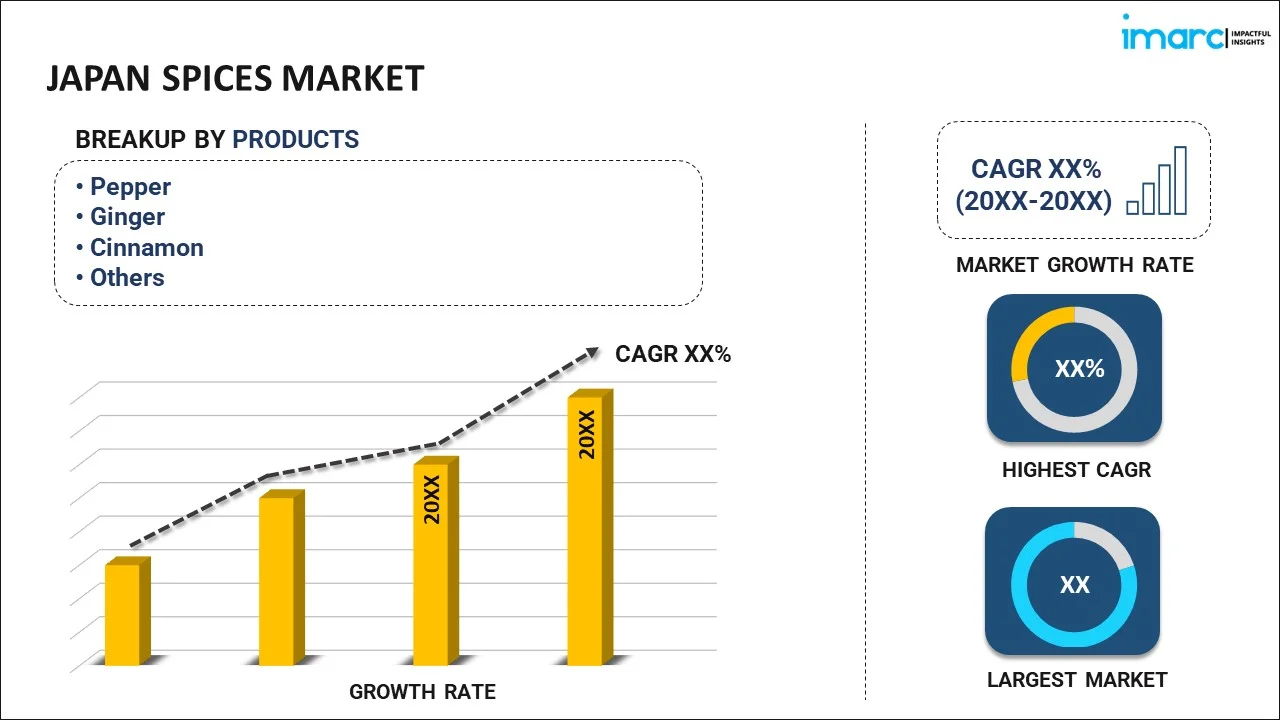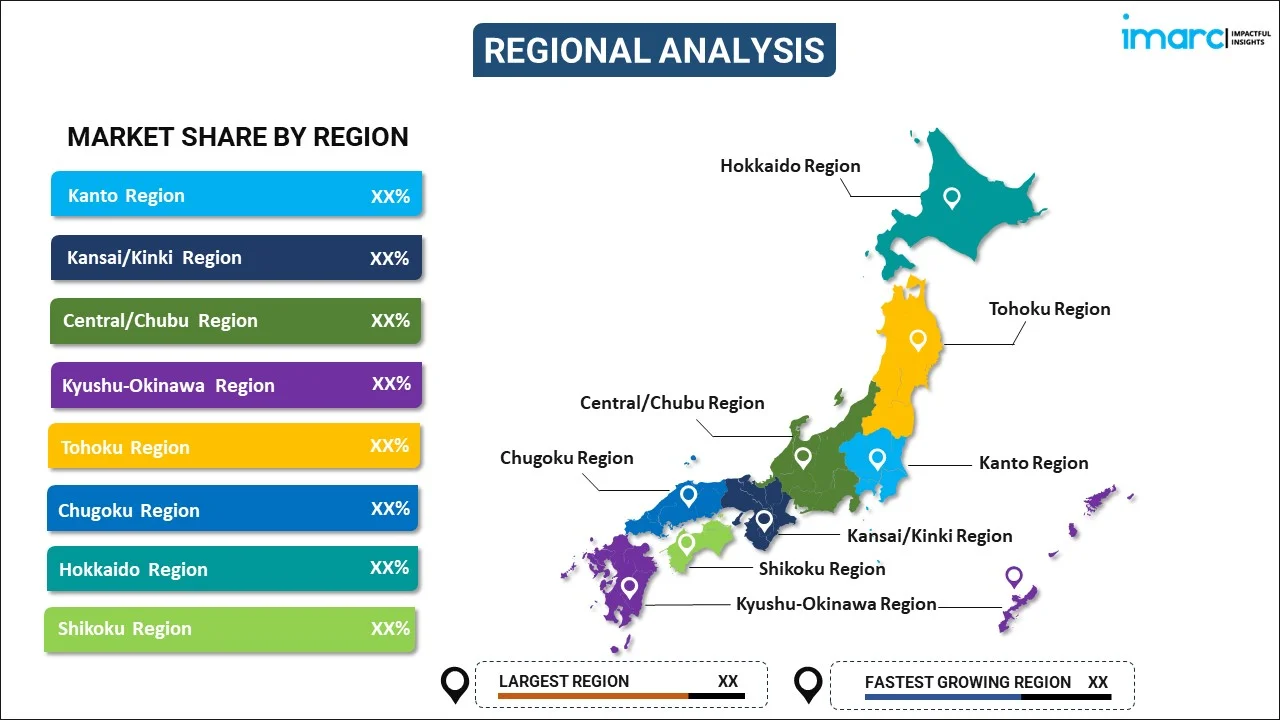
Japan Spices Market Report by Product (Pepper, Ginger, Cinnamon, Cumin, Turmeric, Cardamom, Coriander, Cloves, and Others), Form (Powder, Whole, Chopped/Crushed), and Region 2025-2033
Market Overview:
The Japan spices market size reached USD 992.4 Million in 2024. Looking forward, IMARC Group expects the market to reach USD 1,081.5 Million by 2033. The evolution of Japanese culinary landscape, increasing health and wellness trends, growing interest in home cooking, improving economic factors, widespread adoption of convenience and ready-to-use products and rising export and import opportunities represent some of the key factors driving the market.
|
Report Attribute
|
Key Statistics
|
|---|---|
|
Base Year
|
2024
|
|
Forecast Years
|
2025-2033
|
|
Historical Years
|
2019-2024
|
| Market Size in 2024 | USD 992.4 Million |
| Market Forecast in 2033 | USD 1,081.5 Million |
Spices are aromatic and flavorful substances derived from various parts of plants such as seeds, roots, bark, and fruits. These natural ingredients have been integral to culinary traditions across the globe for centuries, enhancing the taste and aroma of food. Spices are renowned for their ability to transform bland dishes into vibrant and delectable culinary experiences. They are used to add depth and complexity to flavors and also preserve food and promote good health. Some of the most common types of spices include cinnamon, cumin, turmeric, and black pepper. Each spice has its own unique flavor profile, ranging from sweet and warm to earthy and pungent. Spices can be ground into fine powders or used whole, depending on the requirements of the recipes. Beyond their culinary applications, spices have been valued for their medicinal properties. For instance, turmeric is renowned for its anti-inflammatory qualities, while ginger is often used to soothe digestive issues.
Japan Spices Market Trends:
The culinary landscape of Japan has evolved to include a wide variety of international dishes. As Japanese consumers embrace foreign cuisines, there is a growing demand for spices traditionally used in Indian, Thai, Mexican, and other global dishes. This trend has expanded the market for spices beyond traditional Japanese seasonings. Additionally, Japanese consumers are increasingly health-conscious and seek spices that offer flavor and also potential health benefits. Spices like turmeric, known for its anti-inflammatory properties, and ginger, believed to aid digestion, have gained popularity due to their perceived health benefits. Other than this, the COVID-19 pandemic has led to a surge in home cooking as individuals spend more time indoors. As a result, there is a growing demand for spices to enhance homemade meals. Consumers are experimenting with new flavors and cuisines, which drives the sales of various spices. Besides this, economic stability and disposable income levels of the consumers influence willingness to explore and purchase spices. As the Japanese economy remains stable, consumers are more inclined to invest in premium and exotic spices, thereby boosting the market growth. In line with this, busy lifestyles have led to a preference for convenient, ready-to-use spice products. Spice blends, pre-packaged spice mixes, and seasoning sauces have gained popularity as they save time and effort in meal preparation. Furthermore, Japan relies on imports for a significant portion of its spice supply. Changes in global spice production, trade policies, and geopolitical factors can affect the availability and pricing of spices in the Japanese market. Apart from these factors, Japanese cuisine remains deeply rooted in tradition, and certain spices like shichimi togarashi (a blend of seven spices) continue to be popular. Cultural influences play a crucial role in shaping spice preferences and usage patterns.
Japan Spices Market Segmentation:
IMARC Group provides an analysis of the key trends in each segment of the market, along with forecasts at the country level for 2025-2033. Our report has categorized the market based on product and form.
Product Insights:

- Pepper
- Ginger
- Cinnamon
- Cumin
- Turmeric
- Cardamom
- Coriander
- Cloves
- Others
The report has provided a detailed breakup and analysis of the market based on the product. This includes pepper, ginger, cinnamon, cumin, turmeric, cardamom, coriander, cloves, and others.
Form Insights:
- Powder
- Whole
- Chopped/Crushed
A detailed breakup and analysis of the market based on the form have also been provided in the report. This includes powder, whole, and chopped/crushed.
Regional Insights:

- Kanto Region
- Kansai/Kinki Region
- Central/ Chubu Region
- Kyushu-Okinawa Region
- Tohoku Region
- Chugoku Region
- Hokkaido Region
- Shikoku Region
The report has also provided a comprehensive analysis of all the major regional markets, which include Kanto Region, Kansai/Kinki Region, Central/ Chubu Region, Kyushu-Okinawa Region, Tohoku Region, Chugoku Region, Hokkaido Region, and Shikoku Region.
Competitive Landscape:
The market research report has also provided a comprehensive analysis of the competitive landscape. Competitive analysis such as market structure, key player positioning, top winning strategies, competitive dashboard, and company evaluation quadrant has been covered in the report. Also, detailed profiles of all major companies have been provided.
Japan Spices Market Report Coverage:
| Report Features | Details |
|---|---|
| Base Year of the Analysis | 2024 |
| Historical Period | 2019-2024 |
| Forecast Period | 2025-2033 |
| Units | Million USD |
| Scope of the Report | Exploration of Historical Trends and Market Outlook, Industry Catalysts and Challenges, Segment-Wise Historical and Future Market Assessment:
|
| Products Covered | Pepper, Ginger, Cinnamon, Cumin, Turmeric, Cardamom, Coriander, Cloves, Others |
| Forms Covered | Powder, Whole, Chopped/Crushed |
| Regions Covered | Kanto Region, Kansai/Kinki Region, Central/ Chubu Region, Kyushu-Okinawa Region, Tohoku Region, Chugoku Region, Hokkaido Region, Shikoku Region |
| Customization Scope | 10% Free Customization |
| Post-Sale Analyst Support | 10-12 Weeks |
| Delivery Format | PDF and Excel through Email (We can also provide the editable version of the report in PPT/Word format on special request) |
Key Questions Answered in This Report:
- How has the Japan spices market performed so far and how will it perform in the coming years?
- What has been the impact of COVID-19 on the Japan spices market?
- What is the breakup of the Japan spices market on the basis of product?
- What is the breakup of the Japan spices market on the basis of form?
- What are the various stages in the value chain of the Japan spices market?
- What are the key driving factors and challenges in the Japan spices?
- What is the structure of the Japan spices market and who are the key players?
- What is the degree of competition in the Japan spices market?
Key Benefits for Stakeholders:
- IMARC’s industry report offers a comprehensive quantitative analysis of various market segments, historical and current market trends, market forecasts, and dynamics of the Japan spices market from 2019-2033.
- The research report provides the latest information on the market drivers, challenges, and opportunities in the Japan spices market.
- Porter's five forces analysis assist stakeholders in assessing the impact of new entrants, competitive rivalry, supplier power, buyer power, and the threat of substitution. It helps stakeholders to analyze the level of competition within the Japan spices industry and its attractiveness.
- Competitive landscape allows stakeholders to understand their competitive environment and provides an insight into the current positions of key players in the market.
Need more help?
- Speak to our experienced analysts for insights on the current market scenarios.
- Include additional segments and countries to customize the report as per your requirement.
- Gain an unparalleled competitive advantage in your domain by understanding how to utilize the report and positively impacting your operations and revenue.
- For further assistance, please connect with our analysts.
 Request Customization
Request Customization
 Speak to an Analyst
Speak to an Analyst
 Request Brochure
Request Brochure
 Inquire Before Buying
Inquire Before Buying




.webp)




.webp)












